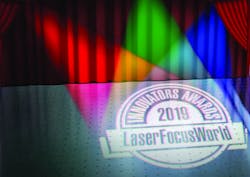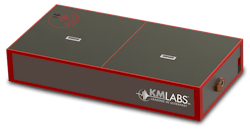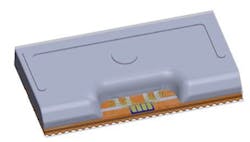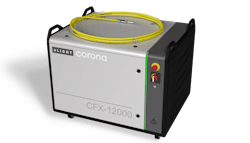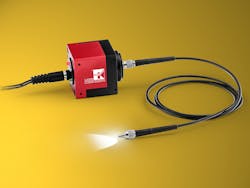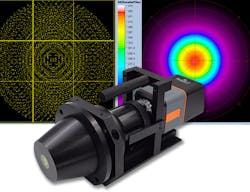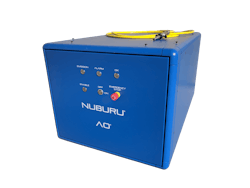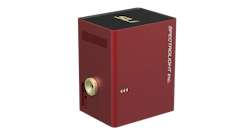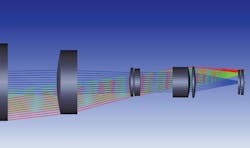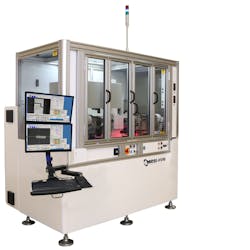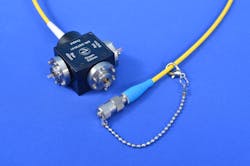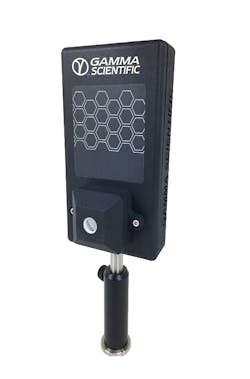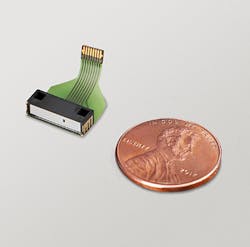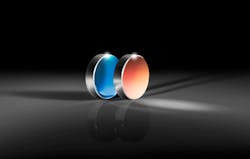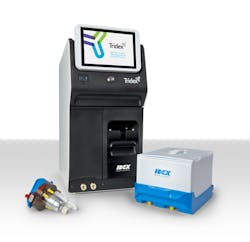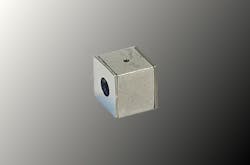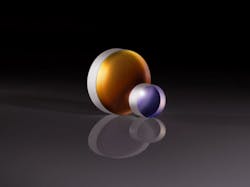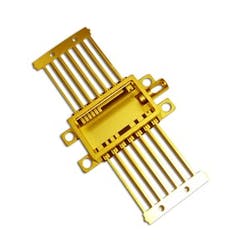Laser Focus World’s Innovators Awards program celebrates the disparate and innovative technologies, products, and systems found in the photonics market.
Based on the impartial ratings by our judges, awards were assigned in four different levels—Platinum, Gold, Silver, and Bronze—to companies or organizations that demonstrated excellence in a product or technology, an application, or in research and development.
Submissions were judged on originality; innovation; their impact on designers, systems integrators, or users; whether they fulfilled a new market need; leveraged a novel technology; and/or increased productivity.
To celebrate our second annual Innovators Awards Program, Laser Focus World held a webcast ceremony on November 18, 2019, for all honorees. Here in their own words, the 2019 group of honorees provides a look at where we stand on the leading edge of photonics products and applications.
PLATINUM 2019 INNOVATORS AWARDS: PLATINUM-LEVEL HONOREES
LASERS & SOURCES | Hyperion VUV
Hyperion VUV is the first commercial femtosecond laser source to deliver vacuum ultraviolet (VUV) light, allowing researchers to probe material and molecular properties with unprecedented flexibility and on ultrafast time scales. The discrete tunability of the source—a simple computer-selected change of photon energy—provides a powerful capability previously only available at a synchrotron. The ability to easily change the laser wavelength can enhance many experiments. The source is also highly focusable and with the right optics, spot sizes below 10 µm can be obtained. With pulse durations below 250 fs, the source enables researchers to probe ultrafast dynamics of molecules and materials, and a 1 MHz repetition rate enables rapid data collection and avoids space-charge effects. KMLabs (Boulder, CO; www.kmlabs.com)
SPECTROSCOPY | XI - Smart Handheld Raman Spectrometer with Cloud and AI
XI is a cloud AI-based Raman spectrometer with 785 nm laser excitation that is fully integrated with the Cloudminds Data A1 Android smartphone. By leveraging TensorFlow, the handheld Raman adopts AI deep learning algorithms, enabling faster data analysis (<40 ms) with high accuracy even for mixtures of three solid or liquid substances, offering a suitable solution for field applications such as law enforcement and first responders for onsite drugs detection in real time, pharmaceutical raw material ID, QA/QC for process control, and counterfeit detection, where central data management is essential. CloudMinds Technology (Santa Clara, CA; www.cloudminds.com)LASERS & SOURCES | Ultrafast laser driver with high-power, multi-channel for lidar
One issue with lidar technology has been its inability to transmit lasers at short pulses while maintaining high peak power, which is necessary to ensure that the lidar is eye-safe with a long range and high resolution. Addressing this need, Osram worked with GaN Systems to develop a laser driver with a 1 ns pulse rise time, while driving all four channels at 40 A each to deliver 480 W of sustained optical power in a small, thermally efficient design with <3 ns FWHM waveform. Osram Opto Semiconductors (Sunnyvale, CA; www.osram-os.com)GOLD 2019 INNOVATORS AWARDS: GOLD-LEVEL HONOREES
INDUSTRIAL LASER SYSTEMS | Corona
Typical approaches to varying beam properties, such as motorized free-space optics and beam combining, increase system size, cost, and complexity. Corona is a revolutionary new fiber laser with rapidly tunable beam quality (variable BPP). By varying beam properties (size, divergence, shape, etc.) directly from the laser output fiber using a novel, all-fiber mechanism, optimum beam characteristics for an unprecedented variety of processes, materials, and applications can be achieved. Real-time programmability enables adjustments on-the-fly and optimization of each process step using a single laser source, helping tool integrators and end users by dramatically increasing tool productivity and versatility. nLight (Vancouver, WA; www.nlight.net)
LASERS & SOURCES | ALBALUX FM
Combining the reliable efficiency of LEDs with the bright, narrow beams of metal halide and xenon, ALBALUX FM offers contrast-rich and precise illumination. Featuring LaserLight technology from SLD Laser, a patented visible laser-diode-pumped phosphor light that generates 100x the intensity of LED with 1000 candela per square millimeter, its optimized fiber optic coupling ensures maximum emission of white, incoherent light of >150 lumens with 1/10 the beam angle of LED sources. Pairing high light density with narrow beam angles, the module’s high contrast and directional lighting is suitable for medical, machine vision, and specialty lighting applications. Laser Components USA (Bedford, NH; www.laser-components.com)
TEST & MEASUREMENT | Near-Infrared Intensity Lens System
The Near-Infrared (NIR) Intensity Lens system from Radiant Vision Systems combines a Fourier-optic lens with a 16 Mpixel CCD radiometer for precise characterization of NIR-emitting sources (LED, laser) used for facial recognition. The system captures angular data to ±70° in a single image to efficiently analyze emission intensity and dot patterns. The system’s lens maps each emission angle from an NIR light source onto the imaging system’s CCD to capture a 2D polar plot used to evaluate the complete scope of NIR emissions for inconsistencies in radiant intensity, power, and radiant flux across 3D space. Radiant Vision Systems (Redmond, WA; www.radiantvs.com)
LASERS & SOURCES | AO-500 High Power High Brightness Blue Laser
The AO-500 is a fiber-delivered high-power high-brightness blue laser that delivers a minimum of 500 W CW at 450 nm with full modulation up to 500 Hz. Due to high absorption in the blue, the AO-500 enables welding yellow metals spatter-free, dramatically improving the mechanical and electrical performance of welds and joints. Offering high quality and low to spatter-free welding of yellow metals such as copper and gold, the AO-500 dramatically improves process performance. The 400 µm fiber includes a QBH connector and is available with a suite of welding lenses, making it a complete welding optomechanical solution for customers. Nuburu (Centennial, CO; www.nuburu.net)
OPTICS | Flexible Wavelength Selector (FWS) Poly
FWS Poly is a compact, automated device that allows center wavelength and bandwidth adjustment with a circular aperture up to 10 mm with independent center wavelength, bandwidth tuning range, and high transmission efficiency across the visible spectrum. The device can be used together with a camera for spectral imaging or with a broadband light source for a tunable illumination source. Combined with a collimated light beam, the device tunes center wavelength from 350 to 900 nm and adjusts bandwidth from 3 to 15 nm via software and USB. Applications range from hyperspectral imaging, fluorescence microscopy, life science instrumentation, and machine vision to laboratory research. Spectrolight (Irvine, CA; www.spectrolightinc.com)
SOFTWARE | High-Yield Optimization
Traditionally, computer optimization of optical design uses a numerical merit function to represent the simulated system’s optical performance. The conventional design approach maximizes the nominal performance of the design, and then as a separate step adds fabrication tolerances to the nominal parameters so that upon manufacturing, the resulting system still performs to specification. A new method, called High-Yield Optimization, improves on the traditional method by integrating the manufacturing defects into the design process at the start, rather than adding them as a post-design step, producing designs that have superior performance once fabricated. Zemax (Kirkland, WA; www.zemax.com)
SILVER 2019 INNOVATORS AWARDS: SILVER-LEVEL HONOREES
PHOTONIC COMPONENT MANUFACTURING EQUIPMENT | MRSI-HVM Die Bonder
HVM series die bonders offer photonics packaging customers speed, flexibility, and precision in one machine. Its ±1.5 µm at 3 sigma accuracy enables higher levels of photonics component integration density. An integrated turret holding up to 12 tips with “on-the-fly” zero-time tool changing that can handle multiple dies, multiple processes, and multiple products provide the ability to scale quickly and adapt to changing market conditions. Eutectic stage, epoxy dispensing and UV curing, and multiple cameras for parallel image processing, among other features, help increase assembly yield and reduce waste and production costs. MRSI Systems (North Billerica, MA; www.mrsisystems.com)
LASERS & SOURCES | Adaptable RGB Pure Laser
This low-cost and robust three-laser-diode engine is carefully engineered to be adaptable, compact, and ensure excellent power and spectral stability. Combining the attributes of the adjustable lateral-and-tilt alignment and the symmetry of a glass cube, a single mechanically-rigid optical element is deployed for directing three laser beams into one port. This design not only provides more rugged assembly than using discrete WDM plates, but also incorporates identical optical-path lengths of the RGB beams, offering balanced spot-sizes with low beam divergence. It is suitable for the augmented reality and virtual reality industry as a key element for optical engineers to optimize performance of both surface relief and holographic waveguides. OZ Optics (Ottawa, ON, Canada; www.ozoptics.com)
TEST & MEASUREMENT | LambdaMeter
The Wavemon system represents a significant advancement in real-time wavelength measurements. Using a multichannel photodiode system, the unit provides amplitude feedback without the use of an expensive array spectrometer or sensitive optical alignment. Three photodiodes, each with an independent transimpedance amplifier circuit and five gain ranges for each channel, along with proprietary optical filtering techniques, allow for wavelength accuracy of ±0.25 nm and repeatability of ±0.01 nm. A temperature-stabilized feedback loop incorporating PID feedback provides stability and a reduced noise floor. Gamma Scientific (San Diego, CA; www.gamma-sci.com)
DETECTORS & IMAGING | Mini-spectrometer C14384MA
Designers and engineers stand to gain much from the C14384MA mini-spectrometer. With a compact size of 11.7 × 4 × 3.05 mm, this dispersion-based SWNIR spectrometer shows real potential to facilitate more advanced handheld and portable field analysis applications. This all-around sensor offers high sensitivity in the 640–1050 nm wavelength range, making it suitable for food-related applications. For example, the product can detect the absorption of chlorophyll at 670 nm, fat at 930 nm, water at 960 nm, and glucose at 980 nm, which are some of the primary indicators during agricultural product evaluation. Hamamatsu Corporation (Bridgewater, NJ; www.hamamatsu.com)
PHOTONIC COMPONENT MANUFACTURING EQUIPMENT | 6532HP Die Bonder
Designed for assembling photonics packaging, especially VCSEL and photodiode packaging, the 6532HP die bonder combines both high volume and high precision into a unique dual-head solution with parallel processing and 1.5 µm accuracy to automate die presentation for increased bonding throughput. A large and flexible work area enables a range of presentation options from die ejectors for 4–8 in. wafers, 2 in. and 4 in. waffle packs, tape feeders, and custom stages. Bonding options range from pulse heat, steady state eutectic attach, in situ UV cure, and epoxy daubing and dispense. Reliable and accurate part localization maximizes throughput. Palomar Technologies (Carlsbad, CA; www.bonders.com)
OPTICS | X Line Objectives
Ultra-thin edged convex lenses and ultra-thin concave lenses manufactured with proprietary lens polishing technology enable X Line Objectives to overcome tradeoffs between flatness, numerical aperture, and chromatic correction. By packaging more lenses in each objective housing, the design increases the NA, image flatness, and chromatic correction range, and maintains the overall length of the objective lens at the international standard of 45 mm. This plug-and-play compatibility with existing microscopes allows designers and system integrators to improve imaging performance without design changes to the system. Olympus Life Science (Waltham, MA; www.olympus-lifescience.com)
LASERS & SOURCES | QuickSwitch Pulsed Laser Diode (PLD)
The QuickSwitch PLD provides up to 200,000 laser pulses per second, with a typical duration of 2.5 ns, and a peak ranging from 30 to 89 W with short pulse duration of 1.5 to 5 ns and rise time from 500 ps. Integrating a 905 nm laser diode, switch, and capacitor inside a TO56 metal housing to minimize the inductance loop, provide lower operating voltages, and shorter pulses at a low price, the device promises to enable more-accurate lidar systems in passenger vehicles with faster data gathering and a longer operating range, based on the time-of-flight (ToF) principle. Laser Components USA (Bedford, NH; www.laser-components.com)
OPTICS | In-Stock Extreme Ultraviolet Mirrors
Extreme Ultraviolet (EUV) mirrors for use with wavelengths from roughly 10 to 100 nm are used in lithography, nanoscale imaging, and spectroscopy applications. As EUV research expands with the advent of tabletop EUV lasers and laser-like sources, so does the need for off-the-shelf EUV optics in-stock for immediate shipping. The time between ordering an EUV mirror and it shipping is now measured in hours instead of months, which is especially important for quickly repairing broken systems or exploring new ideas for prototyping. This availability significantly impacts designers and system integrators by facilitating trial-and-error and experimentation in EUV systems without the typical huge time investment. Edmund Optics (Barrington, NJ; www.edmundoptics.com)
TEST & MEASUREMENT | Tridex
The Tridex Protein Analyzer uses a long-lasting UV LED as the light source and a UV photodiode detector with an integrated transimpedance amplifier and a simple optical bandpass filter that requires less optical calibration. The solid-state LED with integrated sapphire ball lens improves alignment and optical transmission without expensive focusing optics. A single optical filter provides ease of assembly and lower cost. Compared to existing analyzers using deuterium lamps or xenon flash lamps, the instrument offers high performance in a more-compact device that consumes less power. In addition to fast analysis time, the design also contains no mercury or other heavy metals, which is key for RoHS compliance. IDEX Health & Science (Rohnert Park, CA; www.idexcorp.com)
2019 INNOVATORS AWARDS: BRONZE-LEVEL HONOREES
POSITIONING, SUPPORT & ACCESSORIES | TORNOS Micro Optical Isolator
Designed to be integrated into standard butterfly-package diode lasers for wide-ranging applications where optical feedback adversely affects performance, the TORNOS Micro Optical Isolator can consistently perform at >30 dB isolation and >90% transmission. Placing the isolator inside the butterfly package allows the beam to pass through the isolator in free space before being coupled into fiber. This provides all the benefits of an optical isolator without suffering from losses due to splicing and re-coupling the fiber. Currently available for wavelengths between 633 and 785 nm, an optional waveplate for manipulation of polarization is also available. Electro-Optics Technology (Traverse City MI; www.eotech.com)POSITIONING, SUPPORT & ACCESSORIES | CT-1 Tabletop Vibration Isolation Platform
The CT-1 offers Minus K’s signature 0.5 Hz vertical natural frequency and 2.0 to 2.25 Hz horizontal natural frequency using patented technology that delivers this performance in a 2.25-in.-tall isolation platform that offers 10–100 times better performance than a full-size air table. The completely passive mechanical isolator requires no air or electricity and is suitable for use directly under benchtop instruments. With only two adjustments possible, making it easy to set up and easy to use, the CT-1 not only optimizes critical space utilization, but also provides better ergonomics for viewing through the eyepiece of a microscope. Minus K Technology Inc. (Inglewood, CA; www.minusk.com)OPTICS | Highly-Dispersive Ultrafast Mirrors
Highly-dispersive ultrafast mirrors for dispersion compensation is an important part of ultrafast laser systems. However, such mirrors are expensive and may take up to 16 weeks due to the economics of the required coating runs, which makes it difficult to prototype ultrafast systems or conduct research where large quantities are not needed. Now, a standard selection of highly-dispersive ultrafast mirrors at common wavelengths are available for same-day shipping. By making it economically viable to obtain small quantities and eliminating the long lead times for coating runs, this availability helps designers and system integrators prototype and develop ultrafast sources. Edmund Optics (Barrington, NJ; www.edmundoptics.com)
FIBER OPTICS | Optical telecommunication packages
High-quality and low-cost optical telecommunication packages from Optispac feature metal-ceramic packages that can address a 0.635 mm minimum space between pins for optical transceiver, lock wave, modulator-demodulator, attenuator, detector, pump laser, and industrial high-power laser applications, among others. With a base/heat sink + pipe + window structure, these devices offer high-power operation, electromagnetic shielding, and RF feedthrough, while providing photoelectric connection in hermetically sealed microelectronic packaging for hostile environments. Optispac (Santa Clarita, CA; www.optispac.com)

John Lewis | Editor in Chief (2018-2021)
John Lewis served as Editor in Chief of Laser Focus World from August 2018 through October 2021, after having served as the Editor in Chief of Vision Systems Design from 2016 to 2018. He has technical, industry, and journalistic qualifications, with more than 13 years of progressive content development experience working at Cognex Corporation. Prior to Cognex where his articles on machine vision were published in dozens of trade journals, he was a technical editor for Design News, covering automation, machine vision, and other engineering topics, for over six years.
